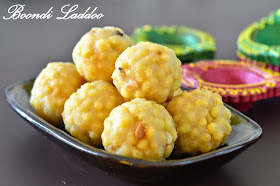This year Karthigai falls on 5th of December. Karthigai is celebrated by sisters for the welfare of their brothers. Nei Appam, Nel Pori, Aval Pori and Adai are usually prepared and offered as neivedhyam in the evening during Sandhya time. Deepam/Vilakku/Diya are lit and placed all around and inside the house.
In our house we usually don't make urundais/balls of the pori, the pori is just added to the jaggery syrup and mixed well. But I made them into balls so that it is easy to handle for my kids and is less messier. Try to use Paagu vellam or dark colored vellam. I could'nt find it here and so had to make do with the white jaggery that is available.
What you’ll need
- Nel Pori – 4 heaped cups
- Powdered Jaggery – ¾ cup
- Water – ¼ cup
- Coconut – ¼ cup, cut into small pieces
- Cardamom Powder – ¼ tsp
- Dry ginger powder/Chukku Podi – ¼ tsp
- Ghee – to grease hand
Method
- Place the jaggery in a heavy bottomed kadai. Add ¼ cup of water and heat the jaggery on medium flame until the jaggery is dissolved completely.
- Strain the jaggery syrup for impurities.
- Wash the kadai and put it back on heat. Pour the jaggery syrup back into the kadai and heat it on medium flame.
- When the syrup starts boiling and frothing, add the coconut pieces and keep stirring.
- Keep a small bowl with water, once the syrup starts becoming thick, pour 2 to 3 drops of syrup in the water, you should be able to form a ball and when you put that ball on a plate, it should give a sound. This is “kal pagam”.
- Once the syrup reaches the kal pagam, turn off the flame and add the cardamom powder and ginger powder and then add pori to it and mix well.
- Transfer to a plate, grease hands with ghee and take a handful of the pori and press tightly in between the two hands and form a ball. Repeat with remaining pori, while the pori is still warm.
Note:
- The sweetness is just right, you can increase the jaggery to upto 1 cup if you like.
- Make sure the syrup reaches the kal pagam, else the pori will settle at the bottom and become soggy.































